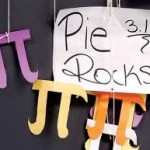Having trouble seeing the relevance of all those formulae in maths?
“THE alarm rings. You glance at the clock. The time is 6.30 am. You haven’t even got out of bed, and already at least six mathematical equations have influenced your life. The memory chip that stores the time in your clock couldn’t have been devised without a key equation in quantum mechanics. Its time was set by a radio signal that we would never have dreamed of inventing were it not for James Clerk Maxwell’s four equations of electromagnetism. And the signal itself travels according to what is known as the wave equation.
The memory chip that stores the time in your clock couldn’t have been devised without a key equation in quantum mechanics. Its time was set by a radio signal that we would never have dreamed of inventing were it not for James Clerk Maxwell’s four equations of electromagnetism. And the signal itself travels according to what is known as the wave equation.
We are afloat on a hidden ocean of equations. They are at work in transport, the financial system, health and crime prevention and detection, communications, food, water, heating and lighting. Step into the shower and you benefit from equations used to regulate the water supply. Your breakfast cereal comes from crops that were bred with the help of statistical equations. Drive to work and your car’s aerodynamic design is in part down to the Navier-Stokes equations that describe how air flows over and around it. Switching on its satnav involves quantum physics again, plus Newton’s laws of motion and gravity, which helped launch the geopositioning satellites and set their orbits. It also uses random number generator equations for timing signals, trigonometric equations to compute location, and special and general relativity for precise tracking of the satellites’ motion under the Earth’s gravity.
Without equations, most of our technology would never have been invented. Of course, important inventions such as fire and the wheel came about without any mathematical knowledge. Yet without equations we would be stuck in a medieval world.
Equations reach far beyond technology too. Without them, we would have no understanding of the physics that governs the tides, waves breaking on the beach, the ever-changing weather, the movements of the planets, the nuclear furnaces of the stars, the spirals of galaxies – the vastness of the universe and our place within it.
There are thousands of important equations. The seven I focus on here – the wave equation, Maxwell’s four equations, the Fourier transform and Schrödinger’s equation – illustrate how empirical observations have led to equations that we use both in science and in everyday life”.
Intrigued?
Read more here.
http://www.newscientist.com/article/mg21328516.600-seven-equations-that-rule-your-world.html
There is a cool video clip to watch too!
 The other day, looking for a quick video on the Science of Sport to show a Physics class as a little starter, I went to the Veritasium website to look for some inspiration. I found these two videos which I think have been posted before but are definitely worth a re visit for Science Teachers.
The other day, looking for a quick video on the Science of Sport to show a Physics class as a little starter, I went to the Veritasium website to look for some inspiration. I found these two videos which I think have been posted before but are definitely worth a re visit for Science Teachers.









 I ran across these little Physics related videos the other day. Each one is only about a minute long so a nice little break. They are also aimed at presenting ideas rather than answering questions so could be a good way to stimulate a discussion or a starting point for more research. Cute and accessible for many year levels. Access the videos
I ran across these little Physics related videos the other day. Each one is only about a minute long so a nice little break. They are also aimed at presenting ideas rather than answering questions so could be a good way to stimulate a discussion or a starting point for more research. Cute and accessible for many year levels. Access the videos 
Recent Comments